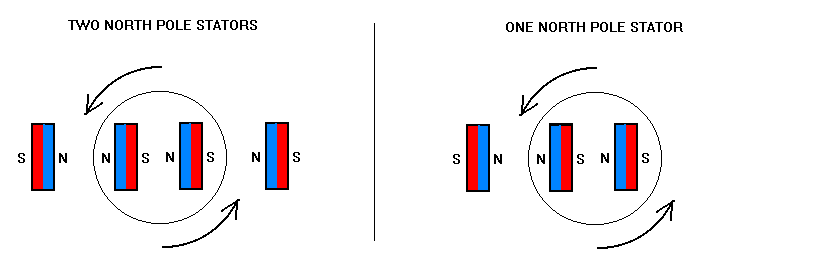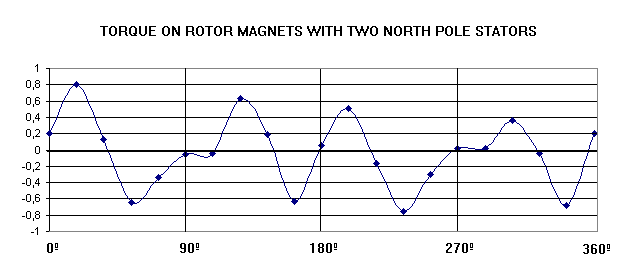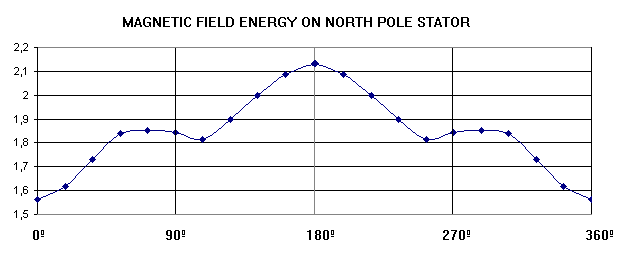
"PHASE OPPOSED REACTION SYSTEMS"
INTRODUCTION:
Sometime ago I was thinking about the Butch Lafonte's method to remove a magnet from the action of magnetic cores without work. This method consisted on a rotor magnet into two attraction-repulsion stator coils in the same axis. This stator coils will cause no torque in the rotor, and the rotor movement will cause no back EMF on the coils, so it's like if the rotor and the coils doesn't interfere each other, and you dont need to apply work, only a current passing through the coils.
I thought about a system were we can get two "phase opposite" actions into two different stator magnets, and also two "phase opposite" reactions into the same rotor ( so zero torque ). This means that we can get double the work of a single stator magnet with (almost) no work in the rotor!. Lafonte needed a current running, but with no work to exert. The only power wasted will be the resistance losses of the coils. Here, we need to turn the rotor, but with no work, only the work to move the mass of the rotor.
First i did some suppositions of how the system will work:
In a rotary magnet with a stator magnet, we got PE to KE conversions on one half of the 360º turning. The rotor magnet wants to front the stator magnet. Then, once fronted, we have to reconvert KE to PE again in the other half cycle to put the system into the initial state, so the work extracted is the same than the work we've got to apply.
In a rotary magnet with two opposite stator magnets, we got PE to PE conversions or "modulations" into the rotary magnets, so we don't need to apply any work to put the system on the initial state, only turn the rotor with little effort will cause the KE and the modulations on the rotor magnets, and the effects on the stator magnets.
The magnetic variations on stator magnets will be the same as on the single stator magnet situation, so we can get the same work than before ON EACH STATOR MAGNET (double work) spending only a little work to move the rotor at certain RPMs!
THE PHYSICAL DEVICES:
To confirm this speculations, I analyzed these systems:

The left picture is the system with two stator magnets in an attraction-repulsion configuration, with PE to PE conversions, so zero torque is expected, little work to apply and double work into the stators than on a single stator system.
The right picture shows a single stator system, with a PE to KE conversion (work done) and a KE to PE conversion (work to be applied).
The rotor magnets turning freely (without any stator magnets) need a zero torque to turn (despising the mass), and has a constant internal magnetic field energy of 2 J / m.
THE TORQUE:
Here we present the torque on the rotor with two stator magnets system:

As you can see, it's not exactly zero. This could be better reduced with an optimized geometry, but it's good enough. If you compare this torque pattern with the torque of the single stator torque pattern, you'll see the big difference:

In this drawing, you can see than the single stator magnets sometimes helps the rotor to turn, and sometimes oppose to this movement in the same quantity, so the same work has to be done to keep the rotor turning. In the two stators system, there is little work needed to turn the rotor.
Then, we have the first advantage probed (ALMOST NO TORQUE NEEDED TO TURN THE ROTOR).
THE MAGNETIC VARIATIONS ON THE ROTOR:
Now, let's see what happens with the magnetic field energy. The following drawing explaine the variations on magnetic field energy inside the rotor magnets in the two stators system:

In this scheme, the energy decreasing on one rotor magnet compensates with increasing energy on the other rotor magnet, so no need of external energy to apply, the medium value of energy remains constant.
Now, The single stator magnet scheme is presented:

You can see that the medium value of magnetic field energy in the rotor magnets doesn't remain constant, This means that sometimes the system need energy from outside to be applied in order to keep this magnetic field variations.
Well, so the second advantage is explained (THE MAGNETIC ENERGY IN THE ROTOR VARIES WITHOUT ENERGY TO APPLY).
THE MAGNETIC VARIATIONS ON THE STATORS:
Are the energy variations "induced" into the stator magnets the same as on a single stator system?
To see what happens on the two stators system, lets draw the magnetic field energy of each one:

You can see you obtain a megnetic field variation "phase opposed" into each one of the stator magnets. This variations will annul if applied in the same magnet at the same time, but each stator magnet "feels" this variations independently, so we can use it.
The magnetic field variations on the single stator magnet system is pictured below:

You can compare this variations with the left stator magnet of the two stators system:

The last advantage is confirmed (THE EFFECTS ON THE STATORS ARE THE SAME).
You can see the effect on the left stator magnet is the same as the effect on the single stator magnet system...
but you NEED NO WORK to apply in the rotor, and yo've got also ANOTHER "phase opposed" variations on the right stator magnet !
CONCLUSION:
The simulations confirms the speculations done about these systems.
If you can construct a system in wich you obtain two "phase opposed" actions into different elements, and also "phase opposed" reactions in the same element, you can actually obtain more output than input by making the "reactionless" element act as if it were reacting. This will cost you (almost) no energy because of the equilibrium of reactions. You'll make the "reactionless" element react without opposition. (in Lafonte's system, you have to apply current, but the only work needed is ressistive losses, and on the system presented here, you've got to apply a turning to the rotor, but the only work needed is to keep the rotor's mass moving).